[English] 日本語
 Yorodumi
Yorodumi- PDB-6e83: Solution structure of ZZZ3 ZZ domain in complex with histone H3 tail -
+ Open data
Open data
- Basic information
Basic information
| Entry | Database: PDB / ID: 6.0E+83 | ||||||
|---|---|---|---|---|---|---|---|
| Title | Solution structure of ZZZ3 ZZ domain in complex with histone H3 tail | ||||||
 Components Components |
| ||||||
 Keywords Keywords | GENE REGULATION / ZZZ3 / ZZ domain / histone / chromatin | ||||||
| Function / homology |  Function and homology information Function and homology informationATAC complex / Formation of WDR5-containing histone-modifying complexes / regulation of cell division / regulation of embryonic development / Chromatin modifying enzymes / telomere organization / Interleukin-7 signaling / RNA Polymerase I Promoter Opening / epigenetic regulation of gene expression / Assembly of the ORC complex at the origin of replication ...ATAC complex / Formation of WDR5-containing histone-modifying complexes / regulation of cell division / regulation of embryonic development / Chromatin modifying enzymes / telomere organization / Interleukin-7 signaling / RNA Polymerase I Promoter Opening / epigenetic regulation of gene expression / Assembly of the ORC complex at the origin of replication / Regulation of endogenous retroelements by the Human Silencing Hub (HUSH) complex / DNA methylation / Condensation of Prophase Chromosomes / Chromatin modifications during the maternal to zygotic transition (MZT) / SIRT1 negatively regulates rRNA expression / HCMV Late Events / ERCC6 (CSB) and EHMT2 (G9a) positively regulate rRNA expression / PRC2 methylates histones and DNA / Regulation of endogenous retroelements by KRAB-ZFP proteins / Defective pyroptosis / HDACs deacetylate histones / Regulation of endogenous retroelements by Piwi-interacting RNAs (piRNAs) / RNA Polymerase I Promoter Escape / Transcriptional regulation by small RNAs / Formation of the beta-catenin:TCF transactivating complex / Activated PKN1 stimulates transcription of AR (androgen receptor) regulated genes KLK2 and KLK3 / RUNX1 regulates genes involved in megakaryocyte differentiation and platelet function / HDMs demethylate histones / NoRC negatively regulates rRNA expression / B-WICH complex positively regulates rRNA expression / PKMTs methylate histone lysines / Pre-NOTCH Transcription and Translation / Meiotic recombination / Activation of anterior HOX genes in hindbrain development during early embryogenesis / RMTs methylate histone arginines / Transcriptional regulation of granulopoiesis / HCMV Early Events / mitotic spindle / structural constituent of chromatin / nucleosome / nucleosome assembly / HATs acetylate histones / RUNX1 regulates transcription of genes involved in differentiation of HSCs / Factors involved in megakaryocyte development and platelet production / MLL4 and MLL3 complexes regulate expression of PPARG target genes in adipogenesis and hepatic steatosis / chromatin organization / Senescence-Associated Secretory Phenotype (SASP) / histone binding / Oxidative Stress Induced Senescence / gene expression / Estrogen-dependent gene expression / regulation of cell cycle / cadherin binding / protein heterodimerization activity / Amyloid fiber formation / regulation of DNA-templated transcription / regulation of transcription by RNA polymerase II / nucleolus / protein-containing complex / DNA binding / extracellular exosome / extracellular region / zinc ion binding / nucleoplasm / nucleus / membrane Similarity search - Function | ||||||
| Biological species |  Homo sapiens (human) Homo sapiens (human) | ||||||
| Method | SOLUTION NMR / simulated annealing | ||||||
 Authors Authors | Zhang, Y. / Kutateladze, T.G. | ||||||
 Citation Citation |  Journal: Nat Commun / Year: 2018 Journal: Nat Commun / Year: 2018Title: The ZZ-type zinc finger of ZZZ3 modulates the ATAC complex-mediated histone acetylation and gene activation. Authors: Mi, W. / Zhang, Y. / Lyu, J. / Wang, X. / Tong, Q. / Peng, D. / Xue, Y. / Tencer, A.H. / Wen, H. / Li, W. / Kutateladze, T.G. / Shi, X. | ||||||
| History |
|
- Structure visualization
Structure visualization
| Structure viewer | Molecule:  Molmil Molmil Jmol/JSmol Jmol/JSmol |
|---|
- Downloads & links
Downloads & links
- Download
Download
| PDBx/mmCIF format |  6e83.cif.gz 6e83.cif.gz | 454.5 KB | Display |  PDBx/mmCIF format PDBx/mmCIF format |
|---|---|---|---|---|
| PDB format |  pdb6e83.ent.gz pdb6e83.ent.gz | 380 KB | Display |  PDB format PDB format |
| PDBx/mmJSON format |  6e83.json.gz 6e83.json.gz | Tree view |  PDBx/mmJSON format PDBx/mmJSON format | |
| Others |  Other downloads Other downloads |
-Validation report
| Summary document |  6e83_validation.pdf.gz 6e83_validation.pdf.gz | 415.1 KB | Display |  wwPDB validaton report wwPDB validaton report |
|---|---|---|---|---|
| Full document |  6e83_full_validation.pdf.gz 6e83_full_validation.pdf.gz | 595 KB | Display | |
| Data in XML |  6e83_validation.xml.gz 6e83_validation.xml.gz | 23.3 KB | Display | |
| Data in CIF |  6e83_validation.cif.gz 6e83_validation.cif.gz | 42.1 KB | Display | |
| Arichive directory |  https://data.pdbj.org/pub/pdb/validation_reports/e8/6e83 https://data.pdbj.org/pub/pdb/validation_reports/e8/6e83 ftp://data.pdbj.org/pub/pdb/validation_reports/e8/6e83 ftp://data.pdbj.org/pub/pdb/validation_reports/e8/6e83 | HTTPS FTP |
-Related structure data
| Related structure data | 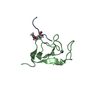 6e86C C: citing same article ( |
|---|---|
| Similar structure data | |
| Other databases |
|
- Links
Links
- Assembly
Assembly
| Deposited unit | 
| |||||||||
|---|---|---|---|---|---|---|---|---|---|---|
| 1 |
| |||||||||
| NMR ensembles |
|
- Components
Components
| #1: Protein | Mass: 7279.126 Da / Num. of mol.: 1 Source method: isolated from a genetically manipulated source Source: (gene. exp.)  Homo sapiens (human) / Gene: ZZZ3 / Production host: Homo sapiens (human) / Gene: ZZZ3 / Production host:  |
|---|---|
| #2: Protein/peptide | Mass: 1308.488 Da / Num. of mol.: 1 / Source method: obtained synthetically / Source: (synth.)  Homo sapiens (human) / References: UniProt: P68431*PLUS Homo sapiens (human) / References: UniProt: P68431*PLUS |
| #3: Chemical |
-Experimental details
-Experiment
| Experiment | Method: SOLUTION NMR | ||||||||||||||||||||||||||||||||||||||||||||||||||||||||||||||||||||||||||||||||||||
|---|---|---|---|---|---|---|---|---|---|---|---|---|---|---|---|---|---|---|---|---|---|---|---|---|---|---|---|---|---|---|---|---|---|---|---|---|---|---|---|---|---|---|---|---|---|---|---|---|---|---|---|---|---|---|---|---|---|---|---|---|---|---|---|---|---|---|---|---|---|---|---|---|---|---|---|---|---|---|---|---|---|---|---|---|---|
| NMR experiment |
|
- Sample preparation
Sample preparation
| Details |
| ||||||||||||||||||||||||||||||||||||||||
|---|---|---|---|---|---|---|---|---|---|---|---|---|---|---|---|---|---|---|---|---|---|---|---|---|---|---|---|---|---|---|---|---|---|---|---|---|---|---|---|---|---|
| Sample |
| ||||||||||||||||||||||||||||||||||||||||
| Sample conditions | Ionic strength: 0.1 M / Label: conditions_1 / pH: 7 / Pressure: 1 atm / Temperature: 298 K |
-NMR measurement
| NMR spectrometer |
|
|---|
- Processing
Processing
| NMR software |
| ||||||||||||||||||
|---|---|---|---|---|---|---|---|---|---|---|---|---|---|---|---|---|---|---|---|
| Refinement | Method: simulated annealing / Software ordinal: 5 | ||||||||||||||||||
| NMR representative | Selection criteria: lowest energy | ||||||||||||||||||
| NMR ensemble | Conformer selection criteria: structures with the lowest energy Conformers calculated total number: 100 / Conformers submitted total number: 20 |
 Movie
Movie Controller
Controller


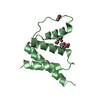
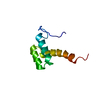
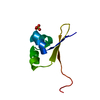
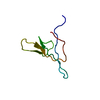
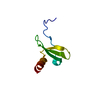

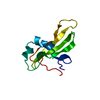
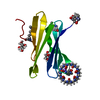
 PDBj
PDBj











 HNCA
HNCA